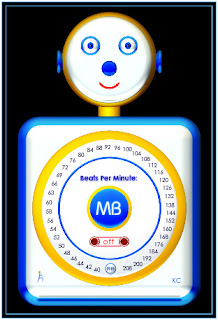One of the best ways for beginner students to improve their musical awareness is to practice with a metronome. Some students get so wrapped up in what they are playing that they are unaware of anything else, including the beat. Playing with a metronome challenges students to listen more carefully to what they are playing, and also requires that they expand their awareness to listen to something other than themselves.
Many students are resistant to playing with a metronome though, and will make comments like these: my metronome makes me frustrated, my metronome speeds up and slows down, I don’t like playing with the metronome, and I hate the metronome.
Here are some thoughts that address each of those complaints.
My metronome makes me frustrated
If you become frustrated playing with a metronome, chances are very good that you have it set at a tempo that is too fast. Slow down and see the post on selecting the best tempo.
My metronome speeds up and slows down
If you are using a wind-up metronome and it is not on a level surface, then maybe your metronome is not keeping a steady beat. Some online metronomes are unreliable, too. For free online metronomes that keep a steady beat, visit www.MetronomeBot.com.
If it seems like your metronome is changing tempo while you are playing, it is more likely that you are not keeping a steady beat. If the metronome seems to speed up when you are playing harder sections and slow down when the music is easier, then you should listen more carefully and play with its tempo. Select a good tempo at which you can play the harder sections. When the music is easier, don’t rush, but be patient and feel the beat.
I don’t like playing with the metronome
If you don’t like playing with your metronome it’s probably because of one of the reasons mentioned above, but you are essentially saying that you don’t like to play at a steady tempo. The beat is the foundation of rhythm, and the metronome is the best tool we have to learn how to develop a good sense of beat. The metronome also keeps us honest, and if we listen carefully to it, we will know when we are speeding up or slowing down. Developing a good sense of beat will help you play better with other musicians, too.
I hate my metronome!
This comment is a bit extreme, but I have encountered students who say it. I tried to create metronomes that are more likable than the standard clicking boxes, and I have found that young students really like MetronomeBot. He talks and offers suggestions, but if you still don’t like him, you can poke him in the eye to vent your frustrations. He’s a robot and he doesn’t mind.
Here are some suggestions for beginners on how to become more accustomed to playing with a metronome:
Clap and count.
Set your metronome to a moderately slow tempo and clap on each beat. While clapping, count the beats for the time signatures of 2/4, 3/4, and 4/4. In other words, for 2/4 time, repeatedly count “one-two” while clapping on the beat. For 3/4 time, repeatedly count “one-two-three.” Do this at several tempos to feel the beat.
Create your own melodies.
After clapping and counting, play along with the metronome at an easy tempo. You can play anything that you like -- just stay with the beat of the metronome.
Visit www.Rhythm-In-Music.com for great rhythm practice patterns.
Play an easy piece that you know very well.
It’s even better if you have memorized it. Listen closely to the click of the metronome and make sure that you are in sync with it.
When learning new music, avoid playing too fast, too soon. See the post on how to determine what tempo to set your metronome.

No comments:
Post a Comment